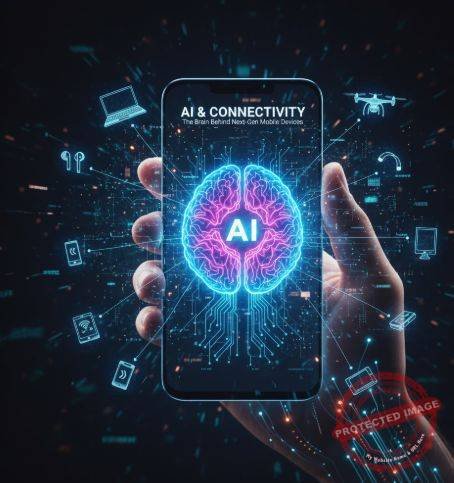How Artificial Intelligence, 5G, and Edge Computing Are Powering a New Generation of Intelligent, Always-Connected Mobility Gadgets.
The Cognitive Leap in Mobility
The world of mobility is undergoing a massive shift. Once driven purely by mechanical engineering, modern mobility gadgets—electric scooters, e-bikes, smart helmets, AR glasses, and even foldable EVs—are now powered by Artificial Intelligence (AI) and advanced connectivity.
AI has become the brain, while connectivity serves as the nervous system of the mobility ecosystem. Together, they enable real-time awareness, adaptive learning, and intelligent decision-making that transforms how people and machines move through the world.
The future of mobility isn’t just faster—it’s smarter.
AI as the Operating System of Motion
Artificial Intelligence is redefining how personal mobility devices operate, learn, and adapt.
-
Predictive Performance: AI analyzes data from sensors, motors, and GPS to optimize power consumption and range.
-
Autonomous Navigation: Smart scooters and delivery bots use computer vision to avoid obstacles and follow routes.
-
Personalization: Devices learn user preferences—adjusting acceleration, lighting, or suspension for comfort and safety.
-
Diagnostics and Maintenance: Machine learning detects wear, battery degradation, and component stress before failures occur.
AI turns mobility gadgets into self-aware machines, capable of evolving and improving autonomously over time.
5G: The Backbone of Connected Mobility
The rollout of 5G networks is unlocking new levels of connectivity for smart mobility. With ultra-low latency and high bandwidth, 5G enables devices to share and process data in milliseconds.
Key benefits include:
-
Instant Communication: Devices can coordinate in real time—essential for traffic safety and fleet management.
-
High-Definition Data Streams: Enables live video, AR navigation, and advanced telemetry.
-
Edge Collaboration: Supports distributed processing between cloud, edge nodes, and devices.
-
Vehicle-to-Everything (V2X): Facilitates communication between mobility gadgets, cars, infrastructure, and pedestrians.
Together, AI and 5G form the digital nervous system of next-generation urban mobility.
Edge Computing: Intelligence at the Source
As mobility gadgets generate increasing volumes of data, sending everything to the cloud becomes inefficient and insecure. Edge computing solves this challenge by processing data locally—on the device or nearby network nodes.
This architecture provides:
-
Real-time decision-making without latency.
-
Privacy protection by keeping personal data on-device.
-
Energy efficiency, reducing the need for continuous cloud communication.
-
Resilience, allowing devices to function even without network access.
From smart helmets that detect crashes to electric skateboards that self-calibrate, edge AI is bringing instant intelligence to every motion.
The Convergence of Devices and Infrastructure
Next-generation mobility isn’t just about smarter gadgets—it’s about smarter environments.
AI and connectivity are enabling symbiotic communication between devices and infrastructure:
-
Smart traffic lights adapt to e-scooter and e-bike flow.
-
Charging stations communicate with vehicles to balance grid demand.
-
City data platforms analyze mobility patterns for planning and emissions control.
This convergence forms the backbone of intelligent transportation ecosystems, where mobility devices, infrastructure, and citizens move in synchronized harmony.
Security and Trust in Connected Mobility
With connectivity comes risk. Mobility devices now store sensitive data—location, user identity, and payment credentials—making cybersecurity essential.
To maintain trust, manufacturers are adopting:
-
End-to-end encryption for all data transmission.
-
Blockchain-based authentication for device identity.
-
Zero Trust frameworks for continuous validation.
-
AI-driven anomaly detection to flag suspicious behavior.
Security-by-design is becoming a defining feature of credible mobility ecosystems, ensuring innovation doesn’t come at the cost of safety.
Industrial and Consumer Applications
AI and connected mobility are transforming both consumer lifestyles and industrial operations:
-
Last-Mile Logistics: Autonomous delivery robots powered by AI optimize routing and efficiency.
-
Fleet Management: Real-time analytics reduce downtime and maximize utilization.
-
Shared Mobility: Smart access systems authenticate users instantly and manage rentals securely.
-
Personal Devices: Riders enjoy context-aware experiences that adapt to surroundings and habits.
These innovations redefine mobility not just as transport—but as an intelligent service.
Closing Thoughts and Looking Forward
AI and connectivity are the invisible forces steering the future of mobility. They empower gadgets to think, communicate, and evolve—making transportation safer, more sustainable, and profoundly more human-centered.
As 5G networks expand and edge intelligence matures, every device—from a smart e-bike to an electric skateboard—will become part of a living, learning network that anticipates human needs before they’re even spoken.
In tomorrow’s world, movement won’t just be mobile—it will be intelligent, connected, and alive.
References
-
“AI and Connectivity in Next-Generation Mobility” – World Economic Forum
https://www.weforum.org/agenda/2024/08/ai-and-connectivity-in-next-generation-mobility -
“5G and Edge Computing: Enabling Intelligent Transportation Systems” – Deloitte Insights
https://www.deloitte.com/insights/5g-and-edge-computing-enabling-intelligent-transportation -
“The Role of Artificial Intelligence in Smart Mobility” – McKinsey & Company
https://www.mckinsey.com/industries/automotive-and-assembly/our-insights/the-role-of-ai-in-smart-mobility -
“Cybersecurity in Connected Devices and Transportation” – MIT Technology Review
https://www.technologyreview.com/2024/10/07/cybersecurity-in-connected-transportation -
“The Future of 5G-Enabled Mobility Ecosystems” – Forbes Tech Council
https://www.forbes.com/sites/forbestechcouncil/2024/09/29/the-future-of-5g-enabled-mobility-ecosystems
Author: Serge Boudreaux – AI Hardware Technologies, Montreal, Quebec
Co-Editor: Peter Jonathan Wilcheck – Miami, Florida
Post Disclaimer
The information provided in our posts or blogs are for educational and informative purposes only. We do not guarantee the accuracy, completeness or suitability of the information. We do not provide financial or investment advice. Readers should always seek professional advice before making any financial or investment decisions based on the information provided in our content. We will not be held responsible for any losses, damages or consequences that may arise from relying on the information provided in our content.



